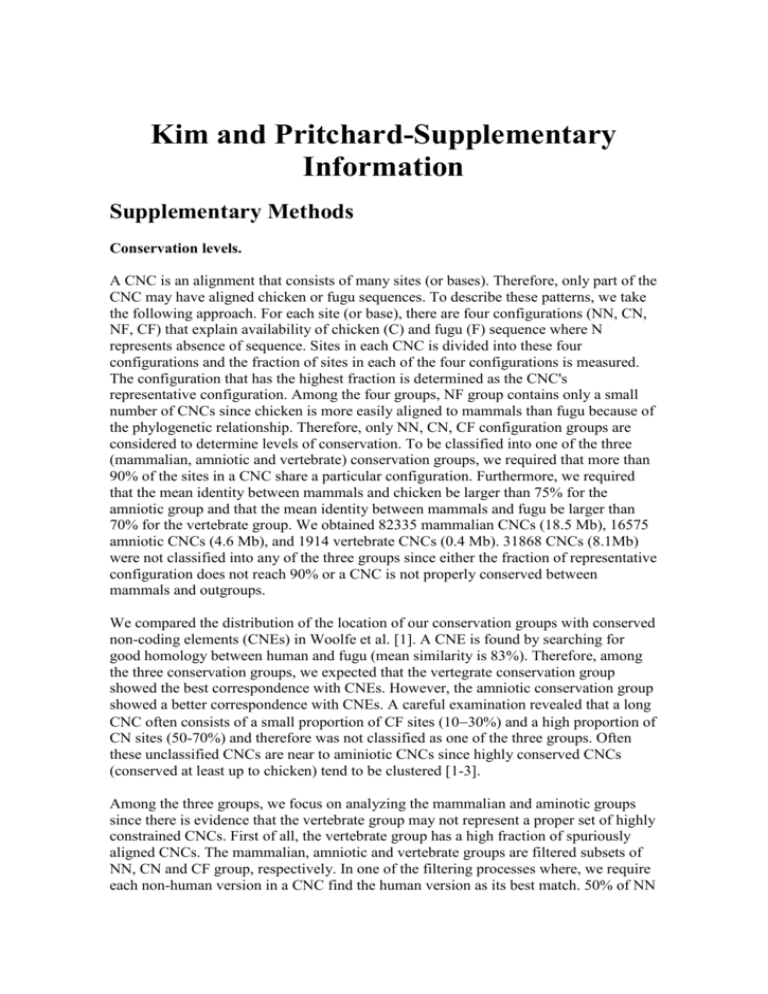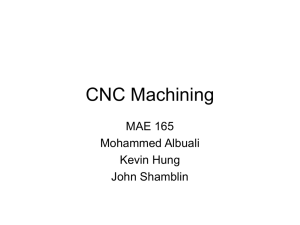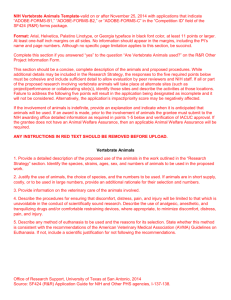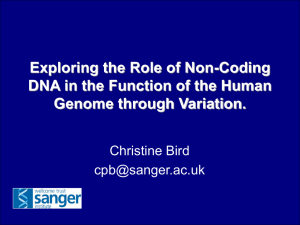Kim and Pritchard--Supplementary Information
advertisement

Kim and Pritchard-Supplementary Information Supplementary Methods Conservation levels. A CNC is an alignment that consists of many sites (or bases). Therefore, only part of the CNC may have aligned chicken or fugu sequences. To describe these patterns, we take the following approach. For each site (or base), there are four configurations (NN, CN, NF, CF) that explain availability of chicken (C) and fugu (F) sequence where N represents absence of sequence. Sites in each CNC is divided into these four configurations and the fraction of sites in each of the four configurations is measured. The configuration that has the highest fraction is determined as the CNC's representative configuration. Among the four groups, NF group contains only a small number of CNCs since chicken is more easily aligned to mammals than fugu because of the phylogenetic relationship. Therefore, only NN, CN, CF configuration groups are considered to determine levels of conservation. To be classified into one of the three (mammalian, amniotic and vertebrate) conservation groups, we required that more than 90% of the sites in a CNC share a particular configuration. Furthermore, we required that the mean identity between mammals and chicken be larger than 75% for the amniotic group and that the mean identity between mammals and fugu be larger than 70% for the vertebrate group. We obtained 82335 mammalian CNCs (18.5 Mb), 16575 amniotic CNCs (4.6 Mb), and 1914 vertebrate CNCs (0.4 Mb). 31868 CNCs (8.1Mb) were not classified into any of the three groups since either the fraction of representative configuration does not reach 90% or a CNC is not properly conserved between mammals and outgroups. We compared the distribution of the location of our conservation groups with conserved non-coding elements (CNEs) in Woolfe et al. [1]. A CNE is found by searching for good homology between human and fugu (mean similarity is 83%). Therefore, among the three conservation groups, we expected that the vertegrate conservation group showed the best correspondence with CNEs. However, the amniotic conservation group showed a better correspondence with CNEs. A careful examination revealed that a long CNC often consists of a small proportion of CF sites (1030%) and a high proportion of CN sites (50-70%) and therefore was not classified as one of the three groups. Often these unclassified CNCs are near to aminiotic CNCs since highly conserved CNCs (conserved at least up to chicken) tend to be clustered [1-3]. Among the three groups, we focus on analyzing the mammalian and aminotic groups since there is evidence that the vertebrate group may not represent a proper set of highly constrained CNCs. First of all, the vertebrate group has a high fraction of spuriously aligned CNCs. The mammalian, amniotic and vertebrate groups are filtered subsets of NN, CN and CF group, respectively. In one of the filtering processes where, we require each non-human version in a CNC find the human version as its best match. 50% of NN and 76% of CN group pass this filtration but, only 30% of CF group do. Since CNCs in CF group are supposed to be conserved across all the vertebrate species, and therefore, presumably have better chance of being properly aligned than CNCs in CN group, it is odd to observe that a smaller fraction of them pass the filtration. Second, the global tree estimated from the all vertebrate CNCs has unusually long primate lineages including the human and chimpanzee lineages. Those lineages are even longer than those from the amniotic group, and again, it seems unreasonable. Also, as previously mentioned, the vertebrate CNCs do not show good match with CNEs. EM algorithm. With given equilibrium frequency = (A, C, G, T) and an evolution model M, we can evaluate the likelihood L of branch lengths v=(v1,, v7) for an alignment of K sites. We use empirical equilibrium frequency estimated from all CNCs and the ``Felsenstein 84'' sequence evolution model. To make computation feasible, the `peeling' algorithm [4] was used with the assumption that sites evolve independently and that given their common ancestor, branches evolve independently. Details of the evolution model and the `peeling' algorithm can be found in Felsenstein and Churchill [5] but here we explain some parts to introduce our EM algorithm. The Felsenstein 84 model is described as having two types of events, I and II with rate of each event and . A type I event is the replacement of the nucleotide at the site by one that is randomly sampled from the equilibrium pool of the same group (purines or pyrimidines). An event of type II replaces the base with one drawn from the pool of all four possible nucleotides with probabilities equal to their equilibrium base composition. The and are determined by the overall rate of substitution per site (set to 1), the ratio of transitions to transversion R (set to 2) and equilibrium frequency (estimated from our CNCs). With this specific model, the explicit form for the continuous transition probability Mxy(v) that a base x is replaced by a base y after a time period v is known (Equation 28 in Felsenstein and Churchill [5]). Since we assume that sites evolve independently, to evaluate the likelihood L for an alignment of K sites, it is enough to compute the likelihood Lj (v) at site j. Note that Lj (v) = P( Dj v ) where Dj is the data at site j. For notational simplicity, fixed parameters such as parameters in the evolution model and equilibrium frequency are dropped from the formula. Using the `peeling' algorithm, we evaluate Lj (v) as x x lrootj(x) where lIj(x) is the conditional likelihood of the tree for all data below node I at site j given that node I is in state x. In principle, we can estimate branch lengths by directly maximizing the likelihood. However, since we need to estimate a set of branch length parameters and local substitution rates of many CNCs jointly under the null model, we used the EM algorithm, which provides an easier solution. To understand our EM algorithm, first suppose that we would like to estimate branch lengths. In this case, we update branch lengths sequentially by computing the expected number of replacements that occur on each branch and repeat this procedure. For example, the branch length vb for lineage b is updated through the following two steps. E-step : Compute E( Nb, j | D j , v( k ) ) M-step : vb( k 1) = 1 1 K j =1E ( N b, j | D j , v ( k ) ) , K where Nb,j is the number of replacement events on lineage b at site j and v(k) is a set of branch lengths after kth iteration. Note that Nb,j is the number of replacement events, not substitution events, and it is assumed to follow a Poisson process with rate +. The details of the E-step are as follows. If lineage b connects two nodes I and J, then, E ( N b, j | D j , v ( k ) ) = nP( N b, j = n | D j , v(k ) ) n=0 = = P ( N b , j = n | v ( k ) ) P ( D j | N b , j = n, v ( k ) ) n=0 P( D j | v ( k ) ) n P ( D j | N b , j = n, v( kb) ) n=0 P( D j | v ( k ) ) nP( N b, j = n | vb( k ) ) = nPoisson (n | v (k ) b n=0 = l ( x) M j x I ( )) x , xy j J (n)l ( y ) y P( D j | v ( k ) ) 1 j j l ( x ) l ( y ) nPoisson (n | vb( k ) ( )) M J (k ) x I P( D j | v ) x y n=0 xy ( n) where M xy (n) is the discrete transition probability that a base x is replaced by a base y after n replacement events. The conditional likelihoods lIj(x) and lJj(y) are evaluated by treating node I and J as subroots taken from the original unrooted tree. The last line is added to improve computation. In practice, instead summing up to , the first 20 terms were used, which we found provides a very accurate approximation. The actual parameters used for SRT were estimated as follows. Under the null, a set of branch length parameters v=(v1,,vb,, v7) were estimated jointly with the local substitution rate rh of each CNC h of length Sh, with an identification constraint in which the mean of the local substitution rates (weighted by CNC length) is 1. Now, instead of updating branch lengths, we updated these parameters. In M-step, vb( k 1) = 1 E ( N h b,h | CNCh , rh( k ) , v ( k ) ) S h h rh( k 1) b E ( N b,h | CNCh , rh( k ) , v ( k ) ) 1 = , S h vb b where Nb,h is the number of replacement events occurred on lineage b in CNC h. Note that the denominator of the right side in the first equation is h Sh instead of h rh Sh because of the identification constraint. Ewens sampling distribution. A natural choice of partition distribution is the Ewens sampling distribution [6]. pn ( B; ) = ( )# B (b 1)!, (n ) blocks where > 0, n is the number of elements in a partition B, #B is the number of blocks, the product runs over the blocks of B, b is a block size. The parameter controls the block size and as 0, the prior of having one block approaches to 1. For our modified AIC, we use Ewens sampling distribution with = 1 to provide a prior for each model that corresponds to a partition of the seven branches into one or more blocks of substitution rate groups. For example, the prior of the second model in Supplementary Table 11 (H C P D T M R) is computed as p7 ( HCP | MRTD ) = 1 (3 1)!(4 1)! . 7! As another example, the prior for the model in which the human and chimpanzee lineages evolve its own rate, while the remaining lineages share a single background rate is p 7 ( H | C | PMRTD ) = 1 (1 1)!(1 1)!(5 1)! . 7! References 1. Woolfe A, Goodson M, Goode DK, Snell P, McEwen GK, et al. (2005) Highly conserved non-coding sequences are associated with vertebrate development. PLoS Biol 3:e7. 2. International Chicken Genome Sequencing Consortium (2004) Sequence and comparative analysis of the chicken genome provide unique perspectives on vertebrate evolution. Nature 432:695-716. 3. Sandelin A, Bailey P, Bruce S, Engstrom PG, Klos JM, et al. (2004) Arrays of ultraconserved non-coding regions span the loci of key developmental genes in vertebrate genomes. BMC Genomics 5:99. 4. Felsenstein J (1981) Evolutionary trees from DNA sequences: a maximum likelihood approach. J Mol Evol 17:368-376. 5. Felsenstein J, Churchill GA (1996) A Hidden Markov Model approach to variation among sites in rate of evolution. Mol Biol Evol 13:93-104. 6. Ewens WJ (1972) The sampling theory of selectively neutral alleles. Theor Popul Biol 3:87-112.







